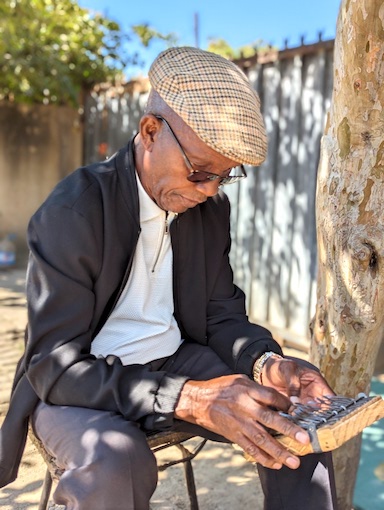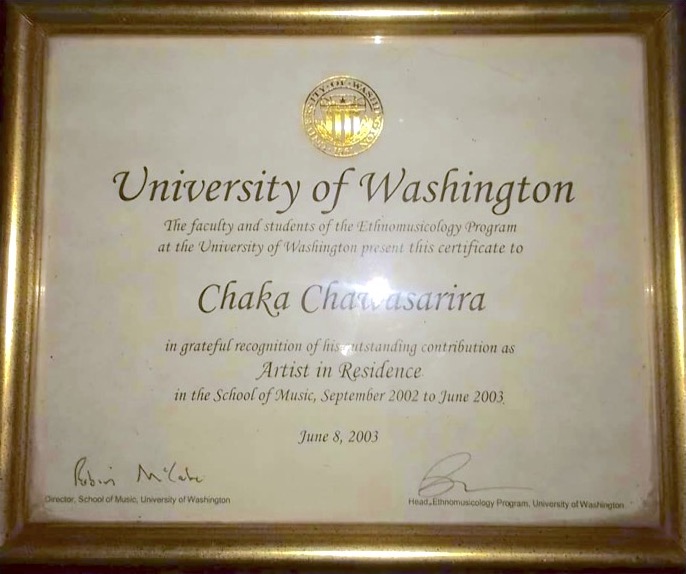Sekuru Chawasarira (*Sept 11, 1941) is one of the most influential figures of his generation of Zimbabwean musicians. An innovator, teacher, and archetypical “musician’s musician” who rarely stood in the front row on international stages, but nevertheless trained and influenced countless students and other musicians.

Dubbed the “Mozart of Mbira” by late composer and cultural promoter Keith Goddard, he was raised as an orphan by German missionaries in a Roman Catholic mission.
Video: Sekuru Chawasarira shares his life story
Video Chapters
Select chapters on video
00:00 Chaka Callisto Chawasarira
02:12 First encounter with matepe players
03:49 Getting his first matepe
04:38 First song to learn
05:39 The thumb issue
07:04 Playing with seasoned matepe players
08:27 Religious aversion against matepe playing
10:40 Moving places
12:36 Going to Kwanongoma College of Music
13:30 First encounter with the 15-key Karimba
15:00 Building karimbas for students
17:22 The 19-key Karimba
18:17 Touring with the youth ensemble
20:03 Performing matepe abroad
26:47 Meeting Mbuya Stella Chiweshe
31:27 Teaching karimba and matepe in Washington
34:57 Retirement and social engagement
35:43 Learning and mastering many instruments
39:07 Building matepe from scratch
40:14 Becoming a church choir master and composer
48:49 Introducing drumming in the church
51:15 Learning to drum
53:13 Pioneers of Shona church music
55:28 Njari and karimba in the church
56:25 Chipendani and the suitors
59:12 Playing Ngororombe
01:00:00 Looking into the future
Two musical worlds
As a teenager, he showed exceptional musical talent and impressed the priests with his self-founded church choir. At the same time, his heart always beat for the traditional music of his homeland and early childhood – his father was a drummer famous in the region, and Chawasarira has already started drumming at young age when his father was still alive.
These two musical worlds and the attempt to reconcile them accompanied him throughout his entire life.
As a young man – meanwhile a teacher at the mission school – he joined the matepe players from his area, including his future friend and mbira teacher Mathias Jackson Chidavaenzi, after realising that their instrument was the one that kept appearing in his dreams.
His talent for the matepe and regular participation in traditional ancestral spirit ceremonies kept arousing suspicion and resentment among his fellow teachers. These tensions were regularly resolved by the missionary priests – who, by today’s standards, were tolerant and open-minded, and who valued his work as a choir master and arranger of church music.
Becoming a matepe player
A few videos about Chawasarira’s formative years as a young man when he became a matepe player:
Video: Chaka Chawasarira’s playing journey
Video: Diwa area and matepe players
Video: Chawasarira’s contemporaries
(Photos and audio clips in the video courtesy ILAM)
Innovations
Chawasarira would eventually become a headmaster, and while studying music theory at the influential Kwanongoma College of Music in Bulawayo he met ethnomusicologist Andrew Tracey, who asked him to become his informant and intermediary for matepe research. Tracey introduced him to the 15-key Kwanongoma Karimba (also known as Nyunga Nyunga), which Chawasarira expanded to his signature 19-key karimba (pictured above) and made the basis of his famous youth music ensembles.
Over the years, Chawasarira first introduced drums, and later also the 19-key karimba, into the services of the Catholic Church. Both against the strong initial resistance of his peers, but ultimately with the approval of the church, which by the time of Vatican II had approved the use of vernacular in worship.
“When I introduced the drumming in 1965 it was a war. They did not accept it until the bishop approved it.
Even up to this day there are some who do not want to play the church drumming approved and accepted by the bishop. They try to distort it in such a way that one cannot understand.”
– Chaka Chawasarira
International recognition
Chawasarira went on to compose an entire mass for the karimba – in a striking parallel to another mbira giant of the period, Njari player Simon Mashoko. His work began to attract international interest, partly through the efforts of his friend, mentor and supporter Keith Goddard.
In the 1980s, Chawararira began working on a book manuscript entitled The Role of Mbira in Shona Society, which remains unpublished to this day. He says he still regrets handing it over to American ethnomusicologists as a source without being cited by them.
In the 1990s, he was one of thirty composers invited to Louisville University in Kentucky, USA, to represent the “best” music of their countries at a festival for contemporary composition (first prize ultimately went to Krzysztof Penderecki). He toured Sweden and Holland with his youth ensembles, and they were regularly summoned by Pres. Mugabe to represent Zimbabwean music at diplomatic occasions at home and abroad.
Chawasira took part as a mbira player in tours through numerous US universities organised by mbira researcher Prof. Paul Berliner, and eventually spent a year as an artist in residence at the University of Washington – he still fondly remembers to be the first to insist that not he himself, but his students would give the farewell concert.

Present
After his retirement and the country’s economic collapse at the turn of the millennium, things gradually became quiet around Chawasarira.
In 2001, American Joel Laviolette, then a matepe student of his, released an amazing studio album on his Mhumi Records label.
A teacher at heart, Sekuru continues to teach and tutor the children of his neighborhood in Chitungwiza. As an instrument maker, his matepes and karimbas are in demand in specialist circles.
With the growing popularity of evangelical and pentecostal churches, the intolerance toward traditional religious practices and their music has only increased. Fundamentalist preachers regularly stigmatise mbira as “music for demons” and blame it for misfortunes and economic problems in families.
These narratives are now widespread among the population and among members of the once more tolerant “old” churches. While things were already difficult when he first introduced it, Chawasarira sees the mbira in the church as a lost cause today. Asked about the idea of documenting and popularising his karimba mass, he replied:
“It is out of the question mbira as such is the most hated instrument by Christians here, as unfit for the church because it is associated with the spirits. Those priests who accepted it are all gone. That is to say karimba for the church is a non starter here these days”
– Chaka Chawasarira
Update: Appreciation by the Archdiocese
In April 2024, Sekuru unexpectedly received this trophy and certificate for his “immense contribution to the sacred Catholic music” and for being a “pioneer of the Zimbabwe Catholic standard drum beat”:
